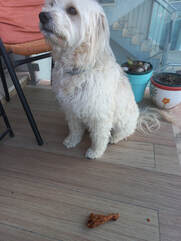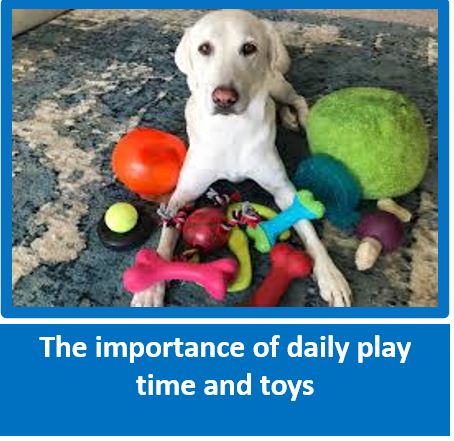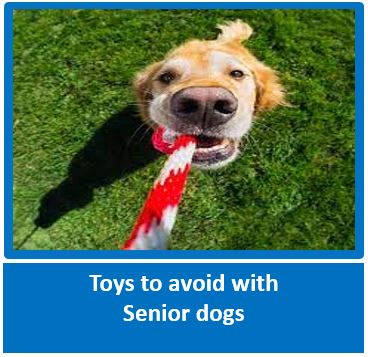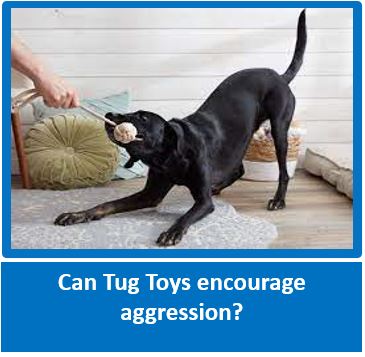
Please visit and LIKE our Facebook Page and share with family, friends and on your own Facebook page, and ask them to share further – it is only by working together and sharing knowledge and education that we can improve the lives of dogs and assist owners. We do not inundate you with posts – an average of 5 per week, and the odd Did You Know. Thank You!
Teaching your dog to Leave an object
by Scotty Valadao - Friends of the Dog
by Scotty Valadao - Friends of the Dog
 Benji, turning his head away when he is given the Leave cue not to eat the piece of chicken in front of him, Scotty is standing in front of the chicken leg, not at where the dog is looking.
Benji, turning his head away when he is given the Leave cue not to eat the piece of chicken in front of him, Scotty is standing in front of the chicken leg, not at where the dog is looking.
Leave, is what we consider one of the most important exercises to teach your dog, and the younger they are when you start, the easier it will be. Don't just perfect this exercise in the home environment, practice when out for walks, and in as many different situations as possible, but only after you have mastered the basics.
Having a solid Leave, can prevent your dog from eating some unsavoury object when out for walks, and even for preventing him from pinching something off the kitchen counter, or if a chicken bone is dropped on the floor for example.
The golden rule where this is concerned - the dog is NEVER allowed access to the object it is told to leave. This is why, when we teach this exercise, we always have 2 types of food - one - some really boring kibble which is kept in the hand you use for the Leave exercise, and then a treat your dog really enjoys, such as a small piece of cheese, some cooked chicken, some biltong, or whatever is your dogs favourite. Treats used are to be small, pea sized pieces, so can be quickly and easily ingested.
Here's How
Exercise One - the Basics
Always teach a new exercise in the home environment, with no other dogs around. Once your dog is ' 'proved' in this exercise, you can start to practice in the garden and in other areas. Don't rush it, having a solid foundation in place right from the beginning, is far preferable, and will make it easier for both you and the dog once you 'up the anti' and start to use really challenging objects.
Prepare before hand so you have at least several pieces of kibble, and some high quality treats as mentioned above. it is a good idea to change the special treats often so that it does not become boring for the dog. Once your dog is proficient, and especially if he is toy driven, you can toss a ball to him as a reward if that would be high value to the dog.
a. Have your dog sitting in front of you, and in your right hand, place the piece of kibble, and close your hand over it - like a fist. In your left hand, do the same, but this time with the high quality treat. Initially, hold this behind your back.
b. Bring the right hand in front of you (leaving the treat hand behind your back), and as your dog starts to sniff it, in a harsh tone and hard voice say 'leave!'. Make your face stern and uninviting as well - you mean it!
c. The very second your dog backs off, looks up at you in surprise, immediately bring the other hand with the high value treat in front of the dog, open the fist out, and say 'take it' good boy in your normal tone of voice.
d. Practice this in the same way several times using the hard voice until your dog totally understands.
e. You can now perform the same procedure, but this time, just a firm 'leave' rather than the hard harsh tone. We start off with the hard, harsh tone for instant effect - a bit like another dog reprimanding your dog for trying to take the object it has, or in front of him. We find that this method is the most effective.
If your dog is fearful, or nervous in any way, rather start with just a firm voice and lower tone.
Practice this in the home, in the garden, out for walks etc. Once your dog is successful, then practice with him standing - he is more likely to be standing up if he comes across something on a walk.
You normally find that once dogs have mastered this skill, that they will simply turn their head away when the Leave cue is given, such as in the picture above.
Exercise 2
We always bring in the second part of this exercise, as it really helps your dog to be successful if he goes to pick up something he is not allowed to have, or something dangerous, especially when out for a walk. It
This time we are going to change the exercise slightly. Stand with your feet about a foot apart, and slightly lift one foot so that you can place the kibble underneath it. Your other hand contains the treat behind your back.
a. Have your dog sitting about a metre away from you, and as he gets close to you to sniff what is under your foot, say Leave - in your stern, but not harsh/hard voice. Your dog has already learnt that Leave results in some nice treat being offered. If your dog backs off, or stops a little away from you immediately offer the high value treat from behind your back, saying 'take it'.
If the dog does not look like going to back off, then simply, lower your foot very quickly to block access to the treat. If this does occur, then go back to using your hard, harsh Leave for a few times, until your dog is successful.
Repeat this several times, and once your dog is successful, then change to having the treat under the other foot to really reinforce the Leave behaviour - just because the dog Leaves the food under one foot, does not mean he will do the same with the other foot!
b. Now that your dog is becoming a 'Pro', start to make the exercise harder, by having the treat a bit away from your foot, but not so far initially, that you cannot step on it. Gradually build up the distance. Being successful at a distance is really important, as the dog is often a bit away from us when we want him to leave something.
You can now practice with all different objects to really reinforce, however, remember to use something that the dog will never be allowed to have, not one of his toys! With exercise 2, remember to practice with the dog standing as well.
Having a solid Leave, can prevent your dog from eating some unsavoury object when out for walks, and even for preventing him from pinching something off the kitchen counter, or if a chicken bone is dropped on the floor for example.
The golden rule where this is concerned - the dog is NEVER allowed access to the object it is told to leave. This is why, when we teach this exercise, we always have 2 types of food - one - some really boring kibble which is kept in the hand you use for the Leave exercise, and then a treat your dog really enjoys, such as a small piece of cheese, some cooked chicken, some biltong, or whatever is your dogs favourite. Treats used are to be small, pea sized pieces, so can be quickly and easily ingested.
Here's How
Exercise One - the Basics
Always teach a new exercise in the home environment, with no other dogs around. Once your dog is ' 'proved' in this exercise, you can start to practice in the garden and in other areas. Don't rush it, having a solid foundation in place right from the beginning, is far preferable, and will make it easier for both you and the dog once you 'up the anti' and start to use really challenging objects.
Prepare before hand so you have at least several pieces of kibble, and some high quality treats as mentioned above. it is a good idea to change the special treats often so that it does not become boring for the dog. Once your dog is proficient, and especially if he is toy driven, you can toss a ball to him as a reward if that would be high value to the dog.
a. Have your dog sitting in front of you, and in your right hand, place the piece of kibble, and close your hand over it - like a fist. In your left hand, do the same, but this time with the high quality treat. Initially, hold this behind your back.
b. Bring the right hand in front of you (leaving the treat hand behind your back), and as your dog starts to sniff it, in a harsh tone and hard voice say 'leave!'. Make your face stern and uninviting as well - you mean it!
c. The very second your dog backs off, looks up at you in surprise, immediately bring the other hand with the high value treat in front of the dog, open the fist out, and say 'take it' good boy in your normal tone of voice.
d. Practice this in the same way several times using the hard voice until your dog totally understands.
e. You can now perform the same procedure, but this time, just a firm 'leave' rather than the hard harsh tone. We start off with the hard, harsh tone for instant effect - a bit like another dog reprimanding your dog for trying to take the object it has, or in front of him. We find that this method is the most effective.
If your dog is fearful, or nervous in any way, rather start with just a firm voice and lower tone.
Practice this in the home, in the garden, out for walks etc. Once your dog is successful, then practice with him standing - he is more likely to be standing up if he comes across something on a walk.
You normally find that once dogs have mastered this skill, that they will simply turn their head away when the Leave cue is given, such as in the picture above.
Exercise 2
We always bring in the second part of this exercise, as it really helps your dog to be successful if he goes to pick up something he is not allowed to have, or something dangerous, especially when out for a walk. It
This time we are going to change the exercise slightly. Stand with your feet about a foot apart, and slightly lift one foot so that you can place the kibble underneath it. Your other hand contains the treat behind your back.
a. Have your dog sitting about a metre away from you, and as he gets close to you to sniff what is under your foot, say Leave - in your stern, but not harsh/hard voice. Your dog has already learnt that Leave results in some nice treat being offered. If your dog backs off, or stops a little away from you immediately offer the high value treat from behind your back, saying 'take it'.
If the dog does not look like going to back off, then simply, lower your foot very quickly to block access to the treat. If this does occur, then go back to using your hard, harsh Leave for a few times, until your dog is successful.
Repeat this several times, and once your dog is successful, then change to having the treat under the other foot to really reinforce the Leave behaviour - just because the dog Leaves the food under one foot, does not mean he will do the same with the other foot!
b. Now that your dog is becoming a 'Pro', start to make the exercise harder, by having the treat a bit away from your foot, but not so far initially, that you cannot step on it. Gradually build up the distance. Being successful at a distance is really important, as the dog is often a bit away from us when we want him to leave something.
You can now practice with all different objects to really reinforce, however, remember to use something that the dog will never be allowed to have, not one of his toys! With exercise 2, remember to practice with the dog standing as well.




